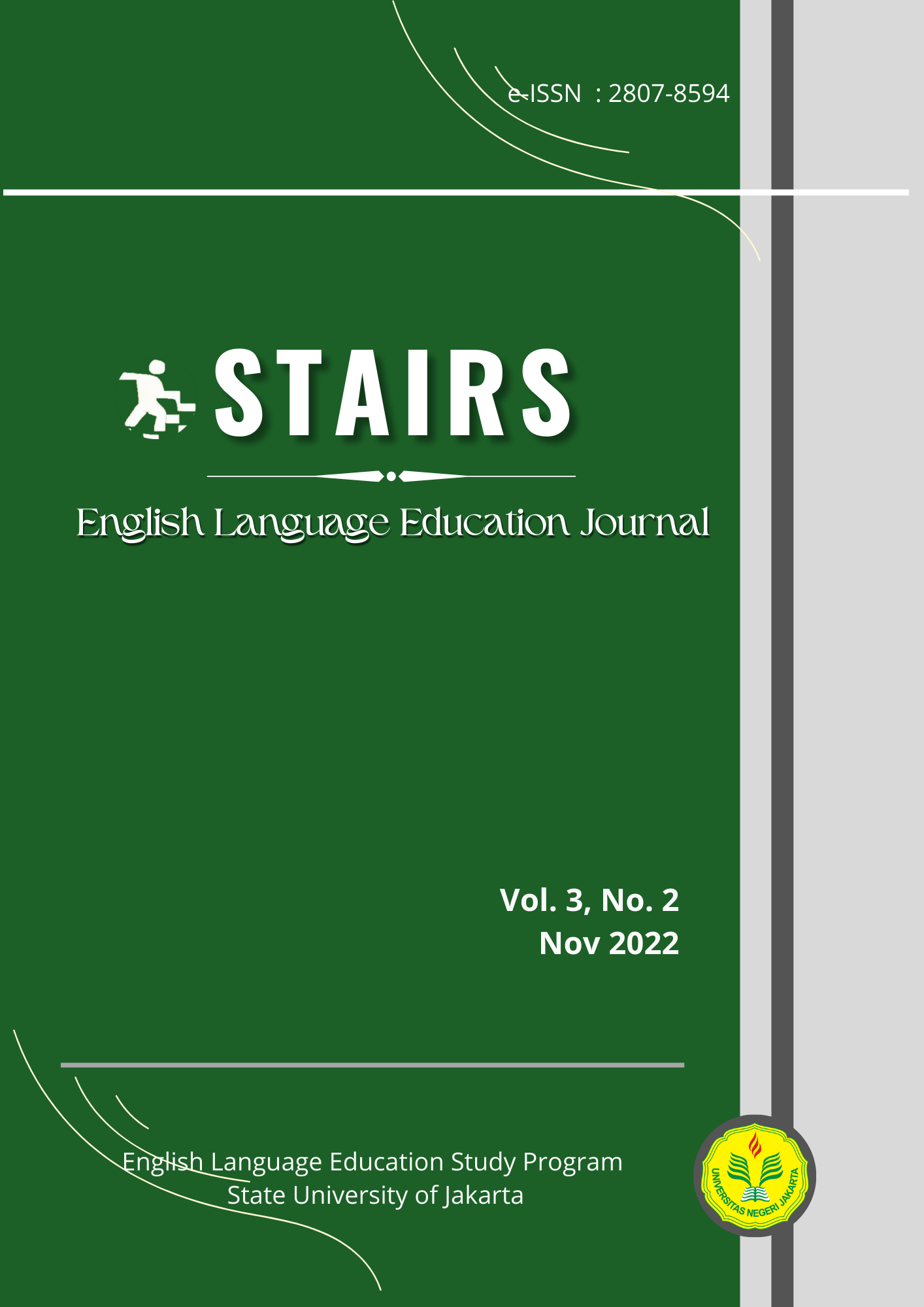The Lexical Density and Experiential Structure of Nominal Groups of the Discussion Section of Skripsis and Research Articles
DOI:
https://doi.org/10.21009/stairs.3.2.4Keywords:
Discussion Section, Experiential Structure, Lexical Density, Nominal GroupsAbstract
This research aimed to see the lexical density of the discussion section of three skripsis (SK) and three research articles (RA) and the experiential structure of its nominal groups. Halliday’s lexical density measurement, which divides the number of lexical items by the number of clauses, was used. It was found that SK has a higher lexical density level than RA (8,5 compared to 6,8). The reason is that one of the SK texts repeats dozens of lexical items in one clause, giving it a high lexical density score. If the text were to be ignored, then SK’s lexical density would be lower than RA (5,7 compared to 6,8). SK was found to have fewer nominal groups than RA (236 compared to 255). RA uses classifier and qualifier, which are realized by lexical items, more than SK, while SK leads in numerative, which is often realized by function words. It is concluded that SK, which has lower lexical density, also uses a more ‘simple nominal group structure’ i.e only having one premodifier or postmodifier, and utilizes lexical items in their nominal groups less frequently than RA did.
References
Arianto, A. M. (2019). Students’ Motivation in Small Group Discussion in Automotive Major SMKN 26 Jakarta. Jakarta: Universitas Negeri Jakarta.
Djiwandono, P. I. (2016). Lexical Richness in Academic Papers: A Comparison Between Students' and Lecturers' essays. Indonesian Journal of Applied Linguistics, 209-216.
Eko, P. (2012). The Analysis of Nominal Group in The Jakarta Post and Asian EFL Journal. Universitas Muria Kudus.
Halliday, M. (1989). Spoken and Written Language. Oxford: Oxford University Press.
Halliday, M., & Matthiessen, C. (2004). An Introduction to Functional Grammar (3rd. ed). London: Arnold.
Hanafiah, R., & Yusuf, M. (2016). Lexical Density and Grammatical Intricacy in Linguistic Thesis Abstract: A Qualitative Content Analysis. English Educational International Conference (pp. 43-46). Banda Aceh: Consortium of Asia-Pacific Education Universities.
Hanipah, S. (2018). The Use of Information and Communication Technology (ICT) based-Activities for Meaningful Learning ( A Descriptive Qualitative Study at SMP Islam Tugasku Jakarta Timur). Universitas Negeri Jakarta.
Khairum, N. M. (2013). A Transitivity Analysis of Genres in the Tenth Grade Senior High School Textbook Developing English Competencies. Jogjakarta: UNY.
Khanifah, S. (2013). An Analysis of Nominal Group and Lexical Density in 'Introductions' of the Articles Found in TEFLIN Journal Volume 23 No 2 July 2012. Universitas Muria Kudus.
Lee, J. S., & Dressman, M. (2018). Brief Report-When IDLE Hands Make an English Workshop. TESOL Quarterly, 435-445.
Mayangsari, A., Fitriati, S. W., & Sutopo, D. (2021). Lexical Complexity and Readibility Realized in The Introduction Section of Selected English Journals. English Education Journal, 298-307.
Moleong, L. (2007). Metodologi Penelitian Kualitatif. Bandung: PT. Remaja Rosdakarya.
Pramono, E. (2012). The Analysis of Nominal Group in The Jakarta Post and Asian EFL Journal. Universitas Muria Kudus.
Rini, R. S. (2012). The Analysis of Nominal Group in the Background of Skripsi Written by English Education Department Students of Teacher Training and Education Faculty of Muria Kudus University 2010. Muria Kudus University.
Sanli, O., Erdem, S., & Tefik, T. (2013). How to Write Discussion Section. Turkish Journal of Urology, 20-24.
Schleppegrell, M. J. (2004). The Language of Schooling A Functional Linguistics Perspective. Mahwah: Lawrence Erblaum Associates.
Snow, C. (2010). Academic Language and the Challenge of Reading for Learning About Science. Science, 450-452.
Sutondo, D. M. (2022). Learning Strategies of ELESP Learners at Universitas Negeri Jakarta in Online Speaking Class. Universitas Negeri Jakarta.
To, V., Fan, S., & Thomas, D. (2013). Lexical Density and Readibility: A Case Study of English Textbooks. Internet Journal of Language, Culture, and Society, 61-71.
Ure, J. (1971). Lexical Density and Register Differentiation. In G. Perren, & J. Trim, Applications of linguistics: selected papers of the second International Congress of Applied Linguistics (pp. 443-452). Cambridge: Cambridge University Press.
Xu, J., & Kou, J. (2018). Brief Report-Group Interaction Strategies and Students’ Oral Performance. TESOL Quarterly, 198-209.
Zhang, L. J., & Curry, M. J. (2018). Brief Report-Effects of Video-Based Interaction on the L2 Listening Comprehension Ability. TESOL Quarterly, 163-176.



